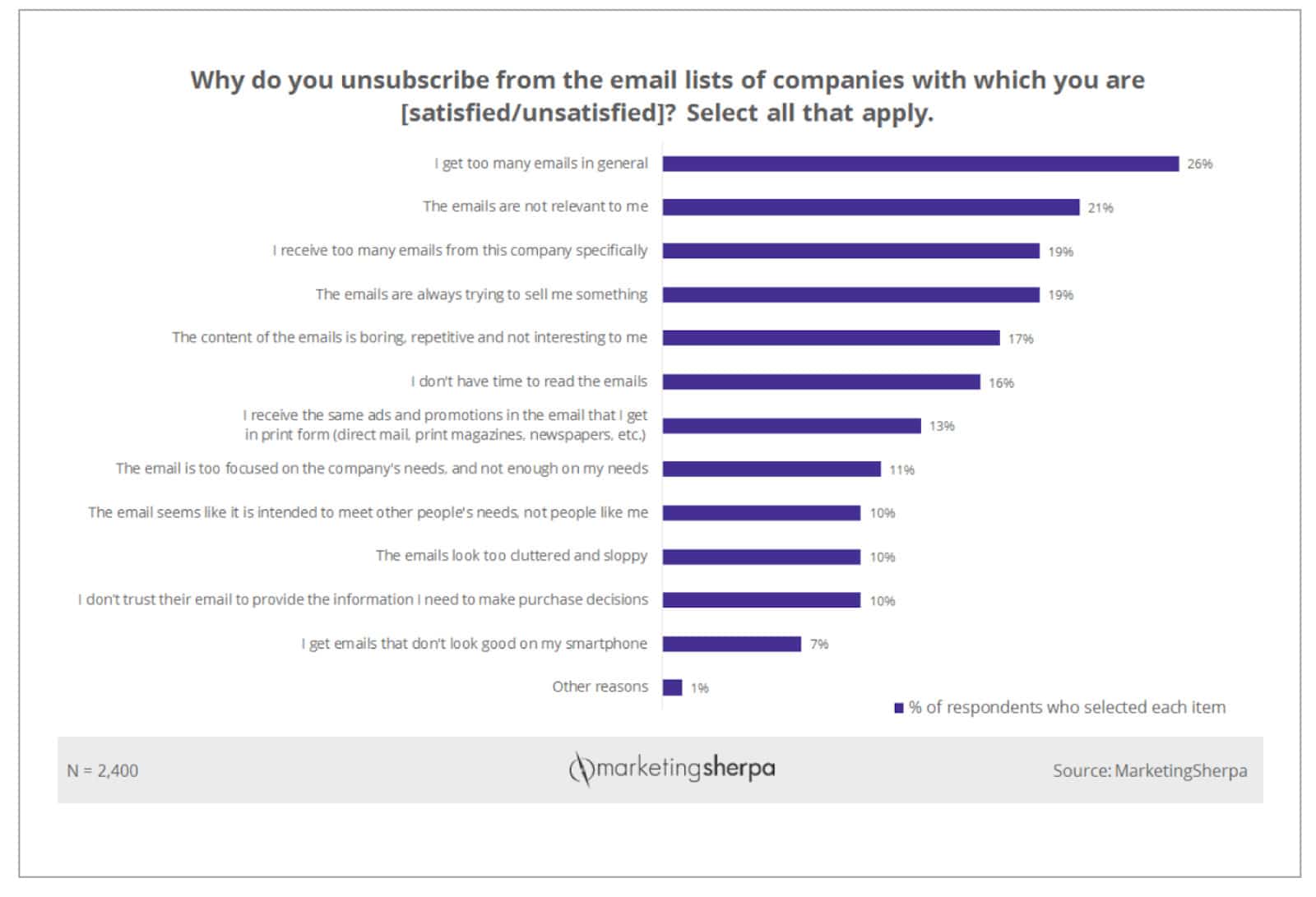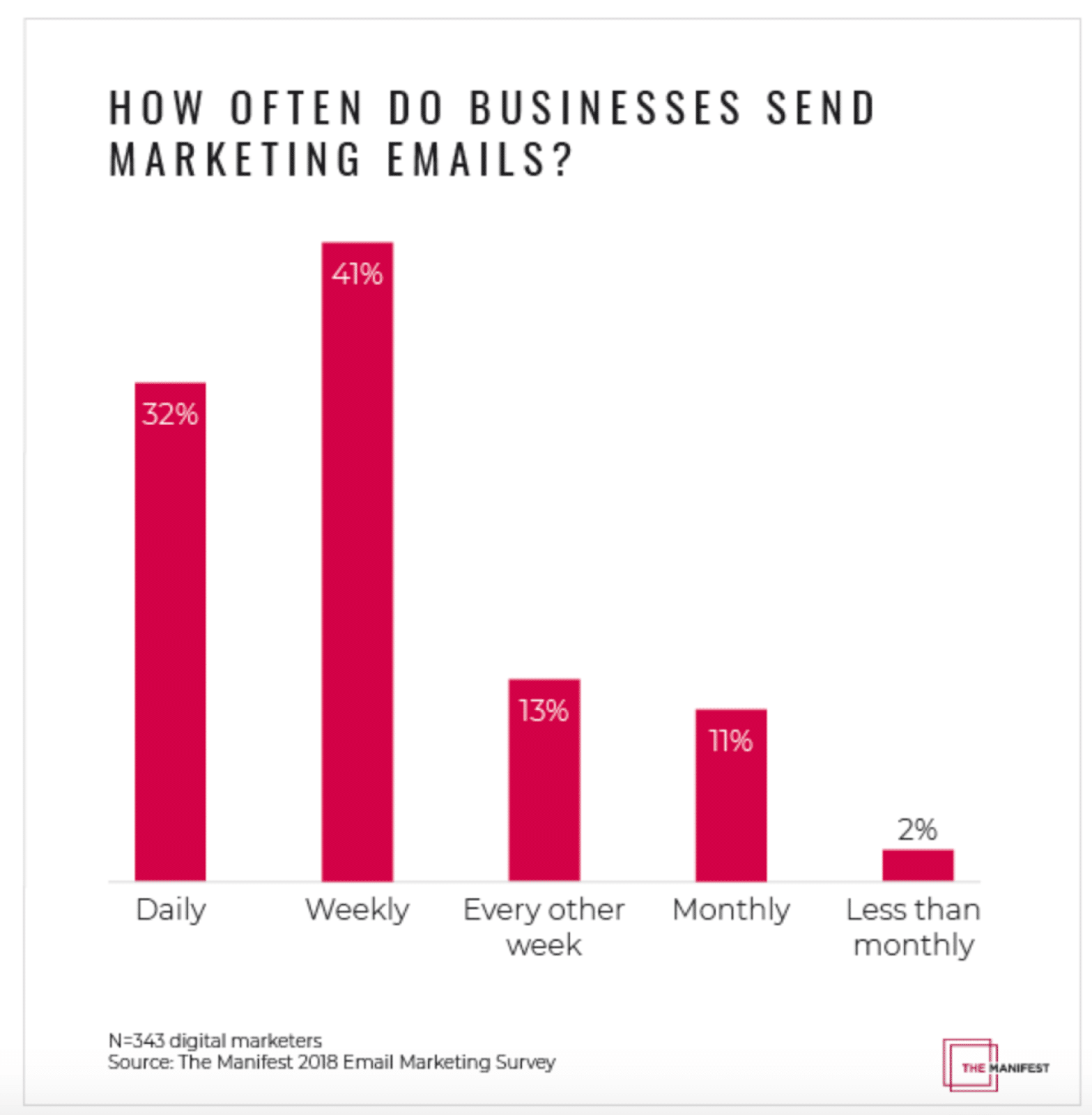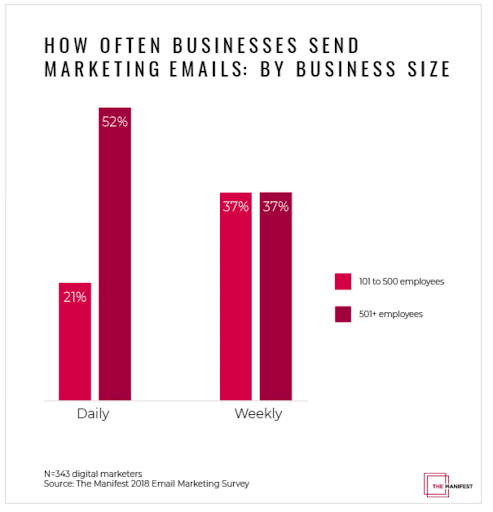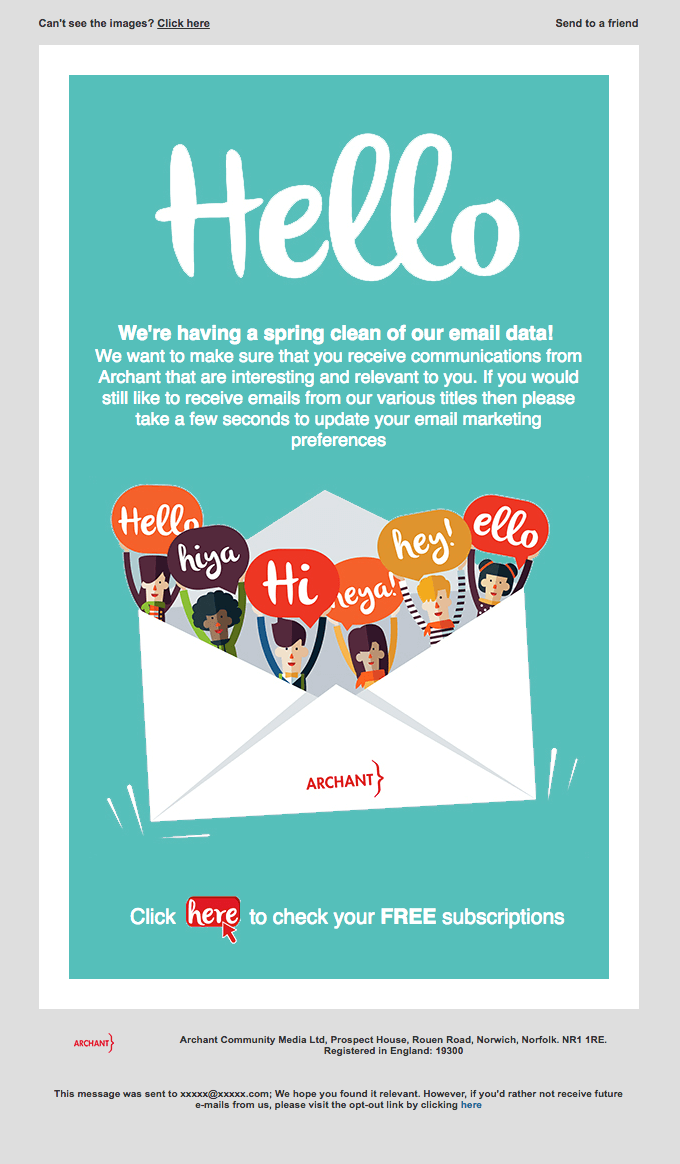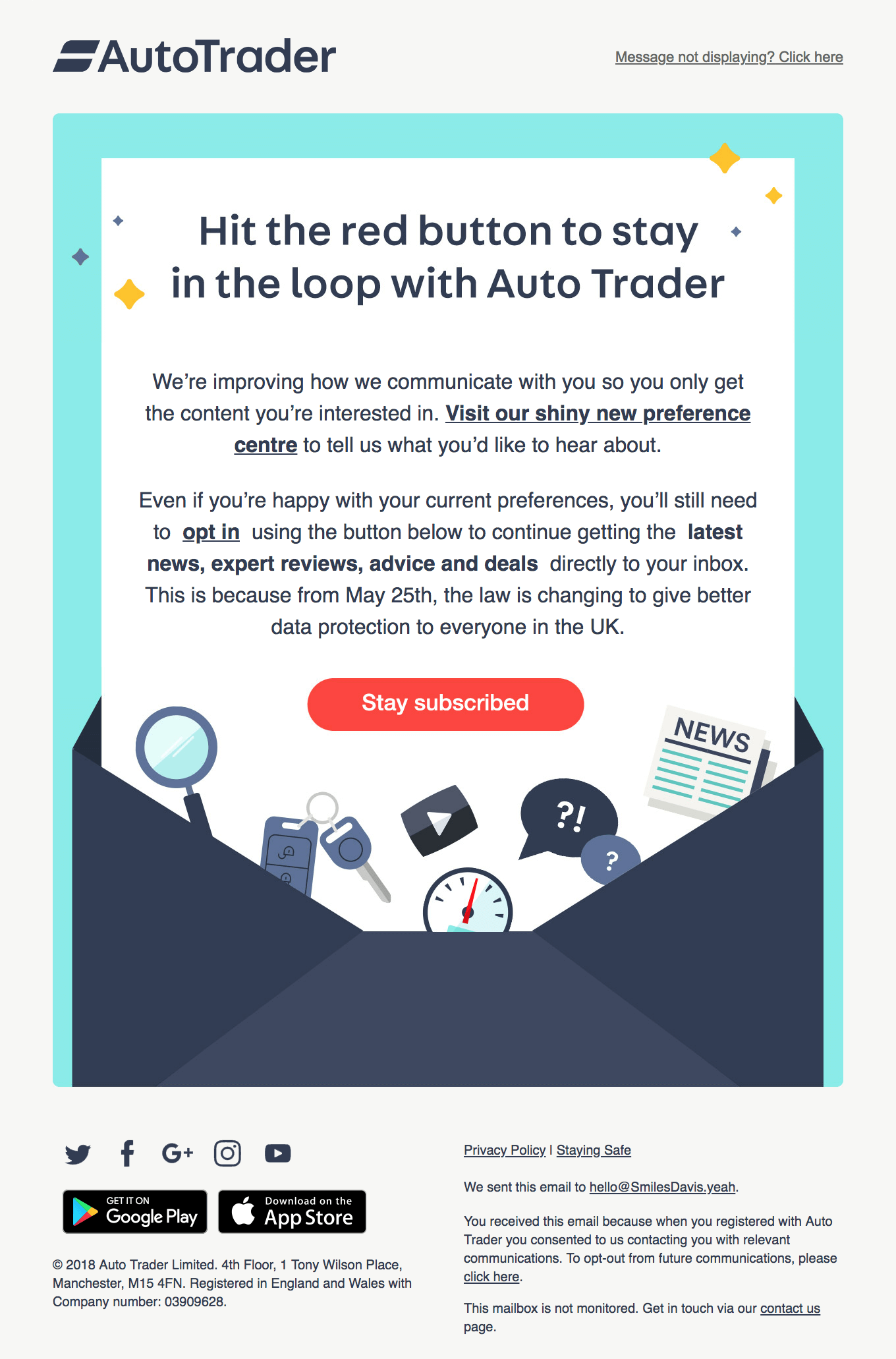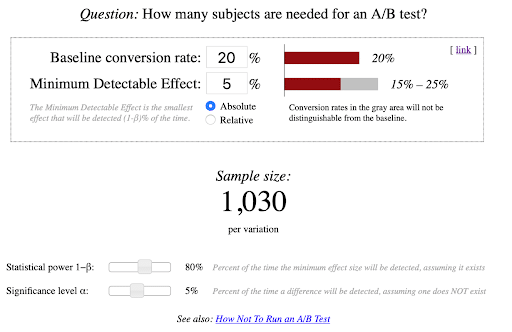Send cadence: The latest data on how often to send emails
This year alone, more than 281.1 billion emails were sent per day. Most business people receive more than 122 emails per day, and that number is projected to rise in the next five years.
Unfortunately, all those emails can get overwhelming, as proven by Marketing Sherpa’s new data showing the number one reason people unsubscribe from emails is “getting too many emails.”
This suggests that nailing proper email frequency is extremely important to keep your emails going into your customers’ inboxes and not their spam folders.
To help you determine the correct frequency for optimal customer retention, we’ve curated the latest data on email frequency to empower you to send confidently and without fear of adding to a noisy inbox.
How often to send emails for best results
The Manifest just completed a volume of research that looked at when and how often businesses were sending emails, and the results of their actions.
Looking at the chart below, it’s easy to see that most businesses send emails weekly or daily:
Additionally, large companies sent more frequently than small businesses, perhaps in part due to budgetary considerations as well as differences in customer base size.
And let’s face it—depending on what line of business you're in, your customers don’t need (or want) to hear from you every day. That means industry considerations and business size both heavily influence send rate.
So, how can you determine the proper send rate for your business?
1. Look at the industry statistics.
As we mentioned before, the frequency in which you send will vary depending on your industry and size of business.
Some businesses, like large retailers, app developers, technology and business-management operations, travel-oriented businesses, and others can send more frequently.
Even if they’re not promoting a product directly, they’re likely to have content that is interesting and useful to customers, which is key to staying in the inbox.
2. Consider your brand's relevance.
Are you a plumber? Then you don’t need to send an email every day or week because your customers aren’t likely to need plumbing services that often.
However, if you provide lawn maintenance and your customer has a contract with you, you can send more often.
In fact, your customers might love receiving timely, relevant emails about seasonal maintenance issues, gardening, or other related subjects. On your end, these emails might be just what you need to upsell customers or get referrals, without appearing too pushy.
If you sell a product that is likely to be re-ordered, like vitamins or groceries, your frequency can keep cadence with your product’s lifespan.
Or, if your product is subject to buying trends like clothing, jewelry, and makeup, your customers may want to hear from you more often to stay up-to-date and on trend with the latest styles.
3. Consider the type of email you send.
Different emails will require various frequencies. For example, a welcome series of emails are normally more frequent than other emails, as you’re capturing interest and building trust.
Over time, welcome emails will slow and you’ll move customers into segmented lists for further marketing, enlist reengagement campaigns for disengaged customers, and clean your list of unsubscribers.
On the other hand, promotional emails need to be carefully handled, as subscribers are sensitive to too many sales-y emails.
However, onboarding emails can be relatively frequent, particularly if customers have opted in or subscribed to a membership with you. This is because they are delivering pertinent content relevant to the opt-in, and chances are your customers are eagerly awaiting it.
4. Allow customer input.
One of the best ways to measure and ensure email frequency success is to ask your recipients directly. You can do this in the form of simply email preference surveys, like the one below:
Image: Really Good Emails
This email empowers subscribers to choose their own frequency and content type and sends the message that Archant values their time.
Using a preference center not only clues you into the right frequency for your target audience, but it also gives you another way to communicate with and engage your customers.
Look at this example from Auto Trader:
Image: Really Good Emails
They’ve clearly explained the different options and value of opting in using the preference center.
Inventiveness and brand personality are still able to shine through, even in your preference center, so be sure to leverage this tool for increased engagement.
5. Test, test, and test again.
A reliable way to understand what the proper email frequency is for your brand is to test it yourself.
Don’t let the idea of running your own data scare you—it’s really simple once you break down the process into individual tasks.
Let’s take a brief look at a simplified testing process.
First, determine your testing goal.
Do you want to lower your unsubscribe rate? Increase lead generation? Fire up click-through rate?
Whatever you choose, be specific.
The more specific you are, the more accurate your test results will be. Think about how you’d like to change your frequency using your current results to hypothesize a new frequency to test.
For example, if you’re getting a lot of unsubscribes and you’re sending daily emails, consider testing a frequency schedule of three times per week to see if your unsubscribe rate declines.
If your unsubscribes drop at three times per week, you can lower your frequency further to twice a week and see if they drop further, flatline, or increase. Continual testing is a good way to determine the “sweet spot” for frequency.
Next, choose your sample.
All you need is a big enough sized list to give you meaningful data upon testing. Evan Miller offers a Sample Size Calculator that can help you determine the best testing group for your goals.
Here’s what it looks like in action:
Image: Evan Miller
If you have a smaller list, say 500 or fewer, you’ll need to look at having a larger minimal detectable effect so you don’t need as many subscribers to get accurate results.
Don’t worry, you can still get accurate data from smaller lists, you’ll just need to adjust some numbers first.
Now, choose your metrics.
You may want to begin with typical metrics measured in email marketing, such as:
- Open rate
- Deliverability rate
- Unsubscribe rate
- Click-through rate
Don’t let yourself be limited by these parameters. You can test any key performance indicator (KPI) that is relevant to your business.
At the core, KPIs give you a way to measure how well your campaign is doing in relation to your marketing team’s objectives and goals.
Schedule and send.
Now that you know what you’re trying to achieve, go ahead and set the frequency schedule you hypothesized in the beginning — in our example, it was moving from daily emails to a three times per week.
Try and keep all other parameters (date of send, time of send, type of email) the same to avoid skewed data.
Monitor and measure.
Measure the results of your new frequency using the metrics you chose earlier. Do you see improvement? Decline?
Regardless of which direction your metrics go, be sure to keep testing over time to really hone your frequency-to-results ratio.
Remember, trends and customer interests are constantly changing. You’ll need to make testing a standard part of your email marketing strategy to keep on the cutting edge of how often to send emails.
Wrap up
Using data from industry sources, your customers, and testing you do yourself will give you a good guideline for how often to send emails without annoying your audience or contributing to list churn.
Customer input is important and valuable, but testing is a significant asset in determining the perfect frequency for your brand and email type. Learning how to perform testing yourself is a valuable skill that you can leverage on future email marketing campaigns — and other aspects of your business.
In addition, it will give you a clearer understanding of the data and how each element of your campaign is functioning in relation to your marketing goals.
Keep testing over time to stay ahead of changes in industry and markets, as well as customer reactions for optimal results and a campaign that gives you the best return on investment.
MOST RECENT ARTICLES
Want to engage your audience and grow your brand? Try Emma's robust easy-to-use product today.

